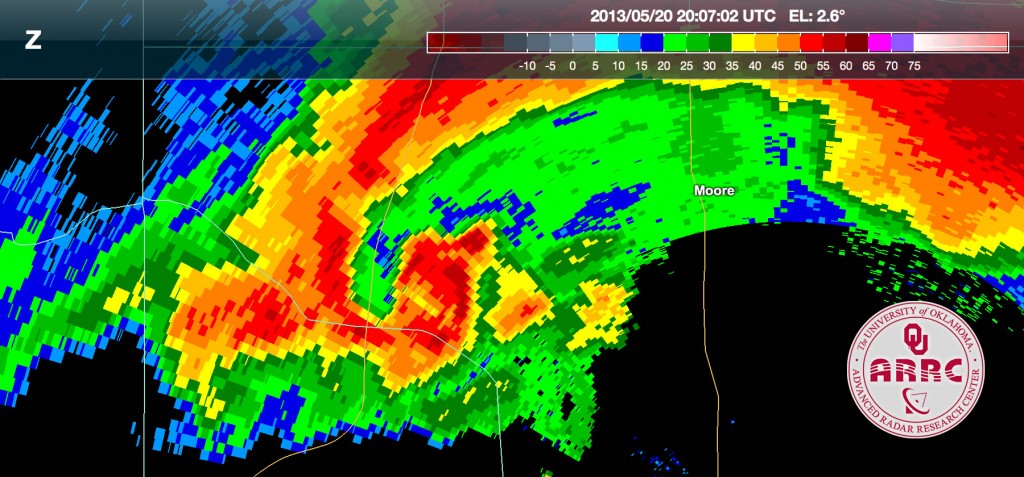OneNet’s High-Speed Capabilities Support Advanced Radar Research in Oklahoma
More than 80 tornadoes touched down in Oklahoma in 2013, including the EF5 tornado that killed 24 people and caused more than $2 billion worth of damage in Moore, Oklahoma. Due to the severe and unpredictable nature of weather in the state, there is a high demand for reliable, innovative weather information. This demand has created a large-scale advanced weather research presence in Oklahoma.
Institutions at the University of Oklahoma such as the Advanced Radar Research Center and the National Weather Center, which predicted the Moore super-cell four days before it happened, rely on OneNet’s high-speed Internet to move vital research data.
With more than 60 graduate and 11 postdoctoral students combined with 18 full-time faculty members, the Advanced Radar Research Center is one of the country’s largest academic research centers focused on advancements in radar, according to the center’s interim director, Tian-You Yu. The center emphasizes rapid hardware prototyping, advanced signal processing, antennas, hydrometeorology, clear-air sensing, sensors, severe weather, applied electromagnetics and microwave engineering.
The Advanced Radar Research Center operates a sprawling fleet of unique, high-tech instruments to investigate and explore new fields of research. One of the center’s latest experiments is a portable weather radar called the PX-1000, which is able to provide highly-detailed observations in areas unreachable to existing radar infrastructure.
“PX-1000 not only observes weather but also provides a platform for research and education due to its flexibility,” Yu said.
The PX-1000 has helped field research from its own backyard to the Korean peninsula. Most recently, the trailer-sized apparatus was taken to Colorado to map weather in areas with holes in the current NEXRAD radar network caused by mountains.
“It was able to see a storm that the WSR-88D [NEXRAD] network totally missed,” Yu said.

On the left is an image of a storm in Colorado from the Advanced Radar Research Center’s PX-1000 radar. On the right is an image of the same storm from the NEXRAD radar network. – Courtesy of ARRC
When the PX-1000 has gathered data, it relays it back to the Advanced Radar Research Center, which relies on OneNet to move its mountains of cutting-edge information. To provide a picture of just how much big data the Advanced Radar Research Center generates, several experiments generate about one terabyte of data each day. A terabyte can hold 1,000 copies of the Encyclopedia Britannica, and 10 terabytes can hold the printed collection of the Library of Congress. In fact, one of the Advanced Radar Research Center’s other mobile radars, the AIR, can generate more than 16 terabytes of data a day due to its multiple channels.
Beyond the Advanced Radar Research Center’s experiments, OneNet also powers the data transfer of a massive hydrometeorology model the center co-developed with NASA led by Dr. Yang Hong. The Coupled Routing and Excess Storage Model can simulate spatial and temporal variation by cell-to-cell simulation. This model has generated more than 300 terabytes of data so far. The 100 gigabit-per-second connection OneNet provides University of Oklahoma to support the Advanced Radar Research Center and the National Weather Center enables this leading-edge research. The development of the PX-1000, alone, creates new research opportunities.
“It opens up potential research topics for us,” Yu said. “But the reliability and quality of PX-1000 have also attracted a number of private companies that are interested in collaborating with the Advanced Radar Research Center to develop the next generation PX-1000.”
The Advanced Radar Research Center’s research not only stimulates Oklahoma’s economy, but also affects the lives of ordinary people through better weather forecasting. OneNet helps make that mission possible.
“The technology OneNet provides Oklahoma empowers not only the Advanced Radar Research Center and the National Weather Center, but research across the Sooner State as a whole,” OneNet Executive Director Vonley Royal said. “OneNet is dedicated to supporting our state’s cutting-edge research by fostering innovation and advancing technology, such as the PX-1000.”
~by Micah Parnell, Outreach Intern, Fall 2014



Just out of curiosity and I know the topographical Terrain around Durango were you able to put the PX 1000 up on a high plateau right around the Durango area. Or is it off to the south and west of Durango 20 or 30 miles in the flatlands..
Hi Tim, Thank you for the comment. I have forwarded it to ARRC, so they can respond to you. We appreciate your interest in our initiatives. Best, April Goode, OneNet Communications Director